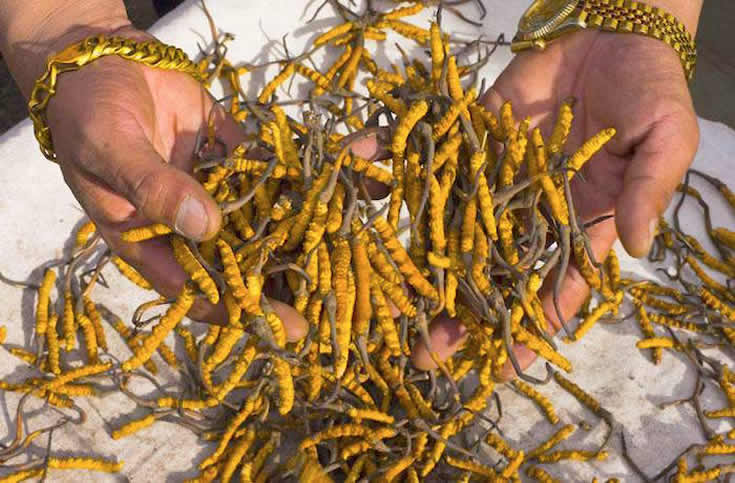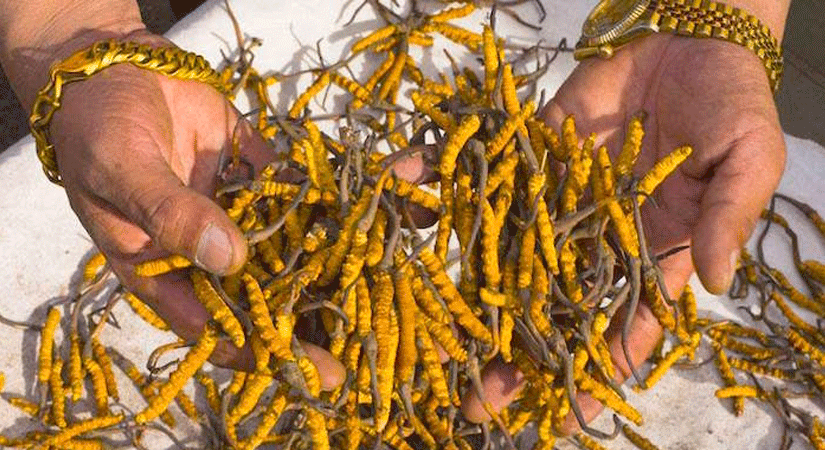Health-Enhancing Benefits of Cordyceps Leave a comment
Cordyceps is a unique and rare form of fungus. Unlike many traditional medicinal mushrooms (e.g., ganoderma, shiitake, coriolus, tremella) that grow on trees, cordyceps begins life in the soil as spores that attach to caterpillars that have burrowed underground to hibernate in the winter. In the summer, Cordyceps emerges from the ground as a stalk that looks a bit like a blade of grass. In Chinese medicine cordyceps is referred to as “winter caterpillar, summer weed” or simply caterpillar grass. Once the fungal stalk is fully grown (reaching up to 3 inches long), it is harvested by hand.
 |
Growing mainly in the mountainous regions of Western China and the Himalayan range, Cordyceps is harvested in Tibet and Nepal. In Tibet, natural cordyceps (called Yartsa Gunghu) is collected in the wild for use in tinctures, or as a ground powder in capsules and tablets.
With current prices for harvested codyceps exceeding $10,000 per pound, the natural mushrooms have become an important source of income for rural Tibetans. A single family working during the summer growing season used to be able to collect between 2 to 8 pounds of cordyceps, enough to cover their expenses for a year. However, competition for the mushroom has grown intense, making it more difficult for many families to find, let alone harvest.
Modern Pharmaceutical Production
To meet demand for the increasingly rare fungus cultivators tried raising caterpillars in large quantities, which were then inoculated with the fungus and left to grow as they would in nature. But even this stop-gap measure failed to meet growing demand, and prices continued to rise. Today, with demand for wild cordyceps continue to increase world-wide, most if not all of the cordyceps used medicinally is produced using fermentation processes to manufacture large quantities of pharmaceutically pure cordyceps that is identical to the wild variety.
Traditional Medicine
Cordyceps is a superstar of the Chinese tonic herbal system, revered as an effective and powerful life-enhancing agent for its ability to prolong life.
In traditional medicine cordyceps is used as a tonic for weakness due to prolonged illness, overwork, and aging. Cordyceps is also a considered to be a major lung tonic, able to strengthen respiratory function in those who require extra energy while performing physical work (e.g. labor, sports or exercise) or by those who suffer from chronic lung weakness (cough, wheezing or shortness of breath).
Cordyceps is one of the primary rejuvenating herbal substances used throughout Asia as an anti-aging agent. It is said to strengthen body and mind at a fundamental level to increase the “primary motive force for life activities.” Because it is both Yin and Yang in nature, cordyceps can safely be used for long periods of time to restore energy reserves depleted by stress, excessive exertion or aging. Consistent use of Cordyceps is said to strengthen the skeletal structure, and specifically benefit the lower back region, the knees and ankles. It is used for backache due to injury, fatigue, stress or simple aging.
Cordyceps is also considered to be a powerful athlete’s tonic – though lacking in steroidal constituents, it is able to greatly improve performance and muscle building capability.
Modern Research
New research on cordyceps is growing in both public and scientific communities based on its ability to promote immune function, lower blood lipids, improve sports performance, and help climbers adjust to life-threatening, hypoxic (below-normal levels of blood oxygen) conditions at higher altitudes.
Much current research is focused on a bioactive components isolated from cordyceps, particularly those that act as biological response modifiers to activate the human immune systems for defensive functions. These immune boosting effects are linked to biological components, such as cordycepin, adenosine, EPSF, cordyglucans, and monosaccharide saponins.
- Cordycepin has been widely explored for its anti-cancer/anti-oxidant activities, and researchers are working to harness its strong pharmacological and therapeutic potential to treat a number of disorders.
- Adenosine plays an important role in biochemical processes involved in energy production as adenosine triphosphate (ATP) and adenosine diphosphate (ADP). Adenosine is also involved in in signal transduction as cyclic adenosine monophosphate (cAMP), and as a neuromodulator for promoting sleep and regulating blood flow to various organs.
- Cordyglucans are another unique component that have been found to exhibit potent anti-tumor activity.
- Cordymin, a peptide purified from cordyceps, has demonstrated potent anti-inflammatory and analgesic properties that have a neuroprotective effect in the brain.
To date, only a handful of the wonders of this ancient traditional compound have been fully explored, but researchers expect that ongoing studies will continue to uncover additional bioactive constituents with potential therapeutic value.
Cordyceps is a one of the primary ingredients contributing to the benefits of several Tango formulas, including Herbal Boost®, FemmePhase®, FloControl®, and MetaPhase®.

